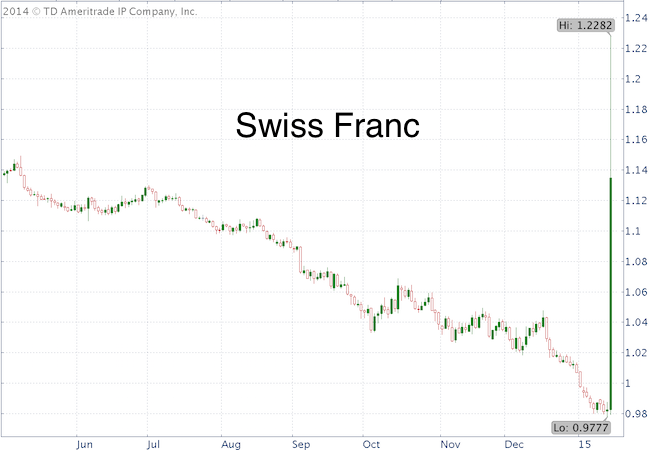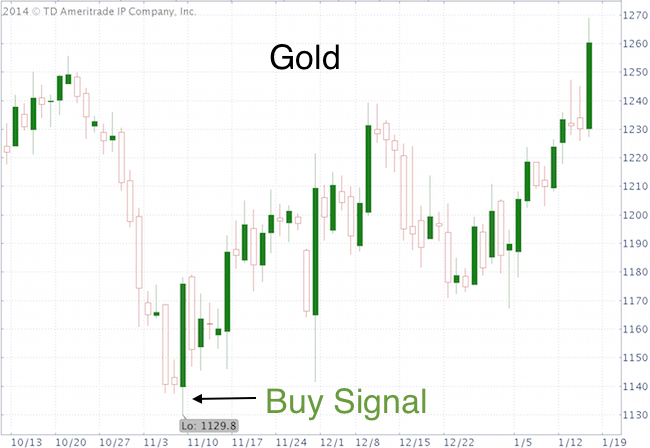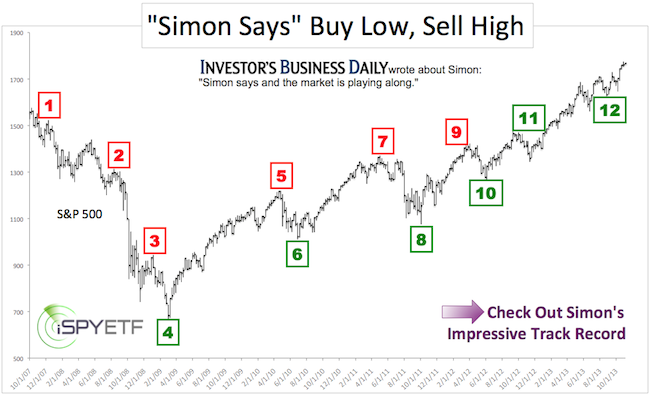Here are the most important words of 2015, thus far:
“Die Schweizerische Nationalbank (SNB) hat beschlossen, den Mindestkurs von 1.20 Franken pro Euro per sofort aufzuheben und ihn nicht mehr mit Devisenkäufen durchzusetzen. Der Ausstieg musste überraschend erfolgen.”
Translated: The Swiss National Bank (SNB) determined to immediately abandon the 1.20 EURCHF floor via currency purchases. This move had to be a surprise.
From September 2011 up until a few hours ago, the SNB has printed francs to buy euros. This kept the value of the franc artificially low.

Why Did the SNB Abandon Franc ‘Stability’
According to Thomas Jordan, President of the SNB, the euro and the franc weakened relative to the U.S. dollar. It therefore was no longer justified to enforce the minimum exchange rate.
Jordan said that maintaining the franc cap long-term would make no sense.
The SNBs balance sheet mushroomed 280% since 2008. Unlike other central banks, the SNB owns predominantly foreign assets, subject to significant currency risk.
It couldn’t depress the franc forever, so now apparently was an appropriate time to stop cold turkey.
It is said that the SNB wanted to move before the European Central Bank (ECB). The ECB is expected to unleash outright QE at next week’s (Thursday) meeting, which will depress the euro even further (more below).
What Does it Mean for Switzerland
Today was a rough day for Swiss investors as the Swiss Exchange closed 8.67% lower. Longer-term, a strong franc is obviously bad for Swiss export and tourism. Swatch CEO Hayed said: “It is a terrible day for corporate Switzerland.”
The surprising rogue SNB move threatens its credibility with market participants worldwide and will make cooperation with the ECB harder.
But the Swiss are no Alpine dummies; they must have weighed the pros and cons and made a decision that’s best for them, a luxury some European Union countries no longer have.
A German/Swiss saying goes something like this: The soup is never eaten as hot as it’s cooked. Although the SNBs decision is today’s ‘hot’ news, its effect tomorrow may only be lukewarm.
Of course, another saying says: You crumbled the cracker in the soup, now you’ve got to eat it (kind of like: you lie in the bed you made).
What Does it Mean for U.S. Investors
Many U.S. hedge funds were short the Swiss franc … and were crushed. My first reaction is that a dose of reality might be an educational change for our financial engineers. It remains to be seen what margin calls will mean for the market.
Most individual investors don’t invest in Swiss currency (NYSEArca: FXF) or swiss stocks (NYSEArca: EWL), so the direct exposure and damage is limited. Broad international ETFs like the iShares MSCI EAFE ETF (NYSEArca: EFA) are actually up today.
U.S. stocks are down again, but that may or may not have been caused by the SNB.
Perhaps more importantly, gold prices soared 2.5%. Via the November 5 Profit Radar Report, I made the (at the time controversial) recommendation to buy gold at 1,140 and GLD at 111.08 and stated that: “Buying and holding gold appears to be one of the best opportunities for the remainder of 2014 and 2015.”
An interesting tidbit: Gold prices topped in September 2011 when Switzerland started to cap the franc.

The next big opportunity may be buying the euro. The ECB is expected to unleash the European version of QE, which theoretically will depress the euro even further.
However, the euro (NYSEArca: FXE) decline is long in the tooth and investor sentiment is extreme. The odds of a major euro rally starting sometime in the next two weeks are high.
I’ll try to identify a low-risk entry point and publish it in the Profit Radar Report.
Simon Maierhofer is the publisher of the Profit Radar Report. The Profit Radar Report presents complex market analysis (S&P 500, Dow Jones, gold, silver, euro and bonds) in an easy format. Technical analysis, sentiment indicators, seasonal patterns and common sense are all wrapped up into two or more easy-to-read weekly updates. All Profit Radar Report recommendations resulted in a 59.51% net gain in 2013.
Follow Simon on Twitter @ iSPYETF or sign up for the FREE iSPYETF Newsletter to get actionable ETF trade ideas delivered for free.

|